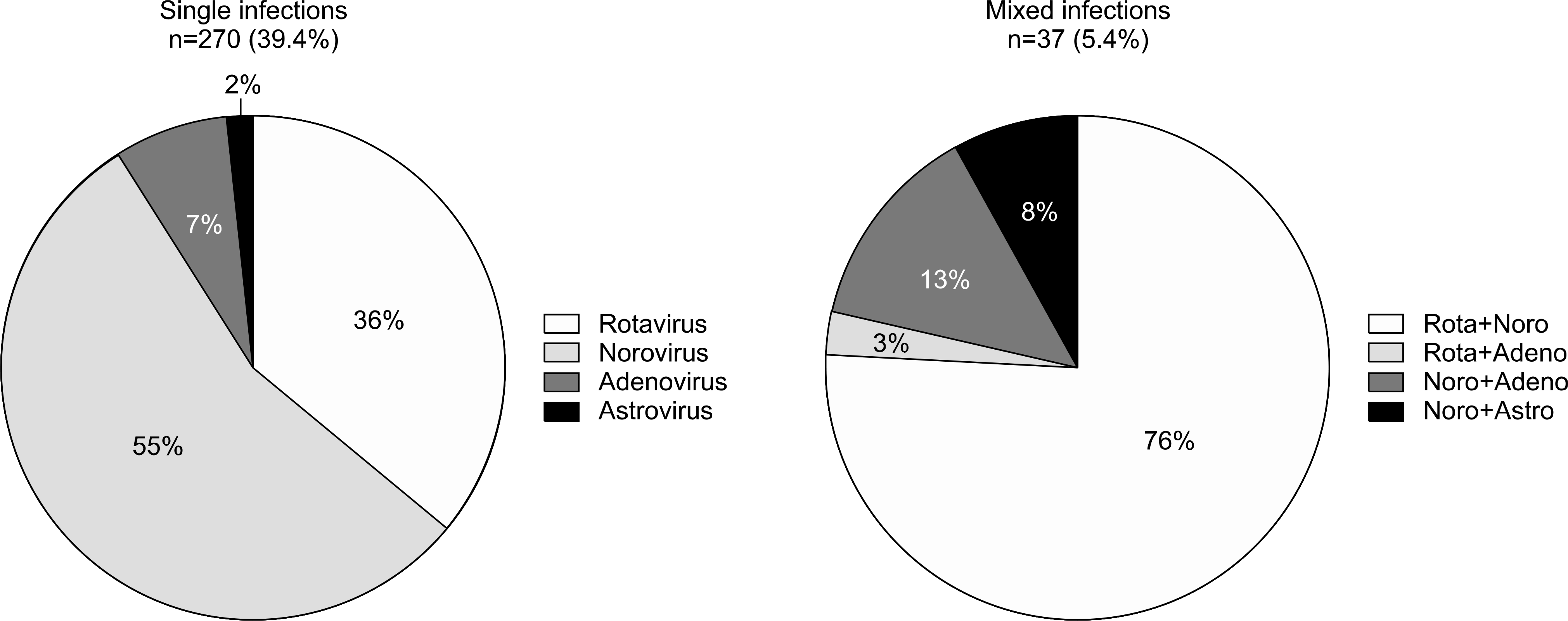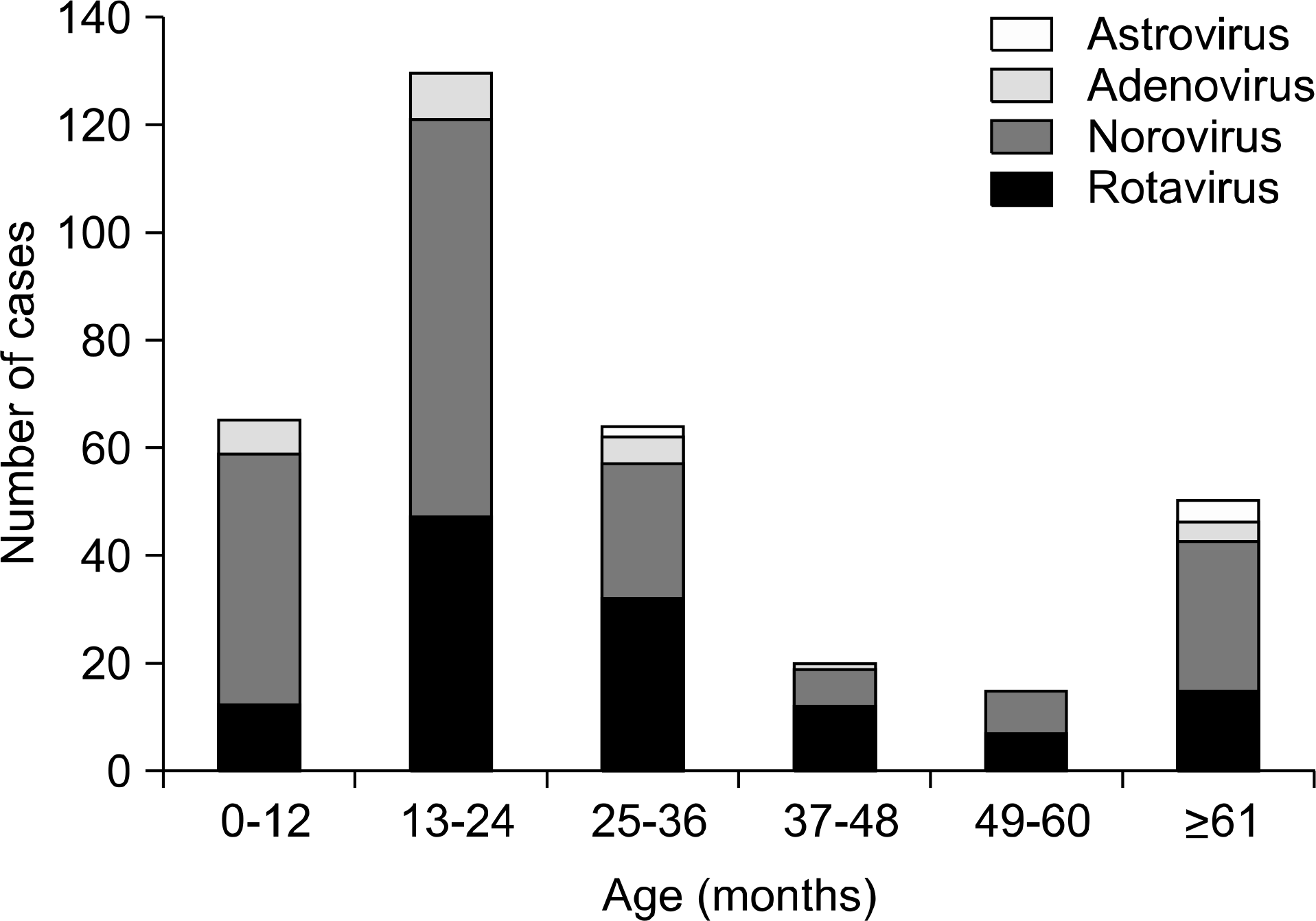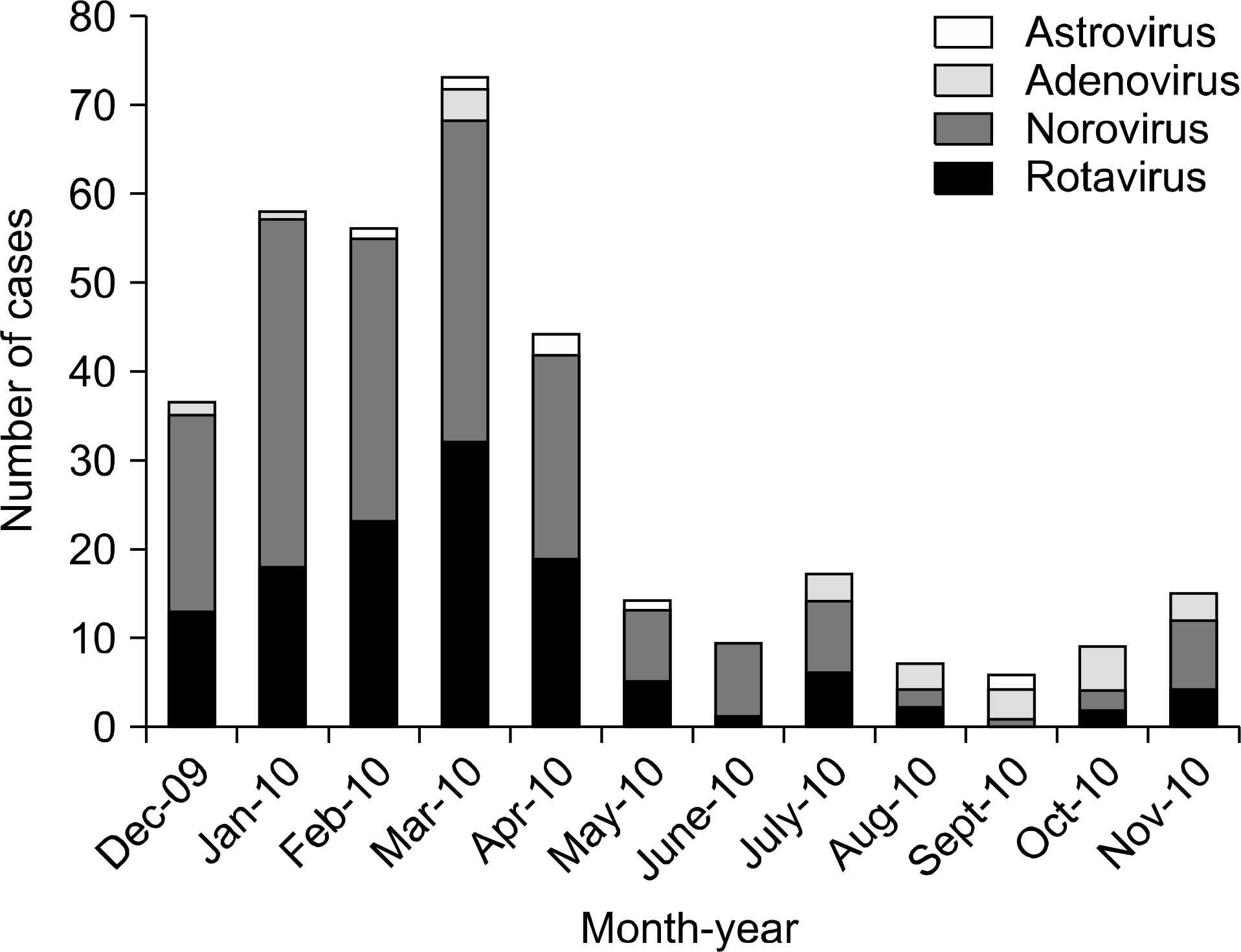Abstract
Background
Acute viral gastroenteritis is a common illness in young children. Rotavirus, norovirus and enteric adenovirus are the major agents for viral gastroenteritis. Their detection rates have gradually increased in Korea. Our aim was to monitor the epidemiologic characteristics of the aforementioned viruses and to determine the laboratory and clinical characteristics of pediatric patients infected with these viruses.
Methods
From December 2009 to November 2010, 685 stool specimens from patients hospitalized at Chung-Ang University Hospital were tested for the aforementioned viruses using multiplex PCR. A corresponding medical record review was retrospectively conducted.
Results
The overall prevalence rate was 44.8%, with rates of 16.3%, 1.9%, 22.7%, 3.1%, and 0.8% for rotavirus, norovirus genogroup I, norovirus genogroup II, enteric adenovirus, and astrovirus, respectively. Mixed virus infections were detected in 37 patients (5.4%). The highest incidence rates occurred in March 2010 (18.9%), in the 13–24 month age group (38.1%), and in males (53.1%). Fever and chills were most frequently observed in patients with adenovirus (44.4%) than other viruses, while diarrhea was most frequently observed in patients with rotavirus (93.7%). Leukocytosis (55.0%) and lymphocytosis (21.0%) were more common in the norovirus-infected group than other viruses-infected group.
Go to : 
References
1. Huh JW, Kim WH, Moon SG, Lee JB, Lim YH. Viral etiology and incidence associated with acute gastroenteritis in a 5-year survey in Gyeonggi province, South Korea. J Clin Virol. 2009; 44:152–6.

2. Parkin PC, Macarthur C, Khambalia A, Goldman RD, Friedman JN. Clinical and laboratory assessment of dehydration severity in children with acute gastroenteritis. Clin Pediatr (Phila). 2010; 49:235–9.

3. Lee JI, Park SH, Kim MS, Oh YH, Yu IS, Choi BH, et al. Surveillance of acute gastroenteritis in Seoul, Korea, during May 2004 and June 2007. J Bacteriol Virol. 2009; 39:363–71.

4. Chung JK, Song HJ, Kim SH, Seo JJ, Kee HY, Kim ES, et al. Epidemiological study of viral diarrhea in Gwangju area during 2000∼2002. J Bacteriol Virol. 2006; 36:195–203.

5. Jang SJ, Kang JO, Moon DS, Lee SH, Yeol AG, Jeong OY, et al. Comparison of clinical characteristics of patients with rotavirus gastroenteritis relative to the infecting rotavirus G-P genotype. Korean J Lab Med. 2006; 26:86–92.
6. Kang JO, Kim MN, Kim J, Suh HS, Yoon Y, Jang S, et al. Epidemiologic trends of rotavirus infection in the republic of Korea, July 1999 through June 2002. Korean J Lab Med. 2003; 23:382–7.
7. Lee JM, Kim HY, Lee MY, Lee KB, Cheon DS, Jee YM. The prevalence and genotypic distribution of group a rotavirus detected from patients with acute gastroenteritis patients in Incheon. J Bacteriol Virol. 2007; 37:39–45.

8. Kliegman R and Nelson WE. Nelson Textbook of Pediatrics. 18th ed.Philadelphia: Saunders;2007.
9. Kapikian AZ, Wyatt RG, Dolin R, Thornhill TS, Kalica AR, Chanock RM. Visualization by immune electron microscopy of a 27-nm particle associated with acute infectious nonbacterial gastroenteritis. J Virol. 1972; 10:1075–81.

10. Bishop RF, Davidson GP, Holmes IH, Ruck BJ. Virus particles in epithelial cells of duodenal mucosa from children with acute non-bacterial gastroenteritis. Lancet. 1973; 2:1281–3.

11. Wilhelmi I, Roman E, Sánchez-Fauquier A. Viruses causing gastroenteritis. Clin Microbiol Infect. 2003; 9:247–62.

12. Jee YM. Epidemiology of norovirus infection in Korea. Korean J Pediatr Infect Dis. 2007; 14:17–24.

13. Yi J, Lee JK, Chung EH, Cho DH, Kim EC. An outbreak of astrovirus infection of newborns with hemorrhagic diarrhea in a neonatal unit. Korean J Clin Microbiol. 2004; 7:55–8.
14. Park DJ, Kim JS, Park JY, Kim HS, Song W, Kim HS, et al. Epidemiological analysis of norovirus infection between March 2007 and February 2010. Korean J Lab Med. 2010; 30:647–53.

15. Barnes GL, Uren E, Stevens KB, Bishop RF. Etiology of acute gastroenteritis in hospitalized children in Melbourne, Australia, from April 1980 to March 1993. J Clin Microbiol. 1998; 36:133–8.

16. Oh DY, Gaedicke G, Schreier E. Viral agents of acute gastroenteritis in German children: prevalence and molecular diversity. J Med Virol. 2003; 71:82–93.

17. Colomba C, De Grazia S, Giammanco GM, Saporito L, Scarlata F, Titone L, et al. Viral gastroenteritis in children hospitalised in Sicily, Italy. Eur J Clin Microbiol Infect Dis. 2006; 25:570–5.

18. Subekti D, Lesmana M, Tjaniadi P, Safari N, Frazier E, Simanjuntak C, et al. Incidence of Norwalk-like viruses, rotavirus and adenovirus infection in patients with acute gastroenteritis in Jakarta, Indonesia. FEMS Immunol Med Microbiol. 2002; 33:27–33.

19. Wiegering V, Kaiser J, Tappe D, Weissbrich B, Morbach H, Girschick HJ. Gastroenteritis in childhood: a retrospective study of 650 hospitalized pediatric patients. Int J Infect Dis. 2011; 15:e401–7.

20. Ma SH. Acute infectious diarrhea in pediatirc patients. Korean J Pediatr. 2005; 48:235–50.
21. Thornton AC, Jennings-Conklin KS, McCormick MI. Noroviruses: agents in outbreaks of acute gastroenteritis. Disaster Manag Response. 2004; 2:4–9.

22. Chung JY. Acute viral gastroenteritis: recent trends and updates. Korean J Pediatr Gastroenterol Nutr. 2007; 10(Suppl 1):53–7.
23. Hwang PJ, Kwak JH, Lee TJ, Jeong SJ. Clinical features of acute noroviral gastroenteritis in children: comparison with rotaviral gastroenteritis. Korean J Pediatr. 2009; 52:453–7.
Go to : 
 | Fig. 1.Prevalence of diarrheal viruses. Distribution of positive cases from December 2009 to November 2010. Numbers in the graph are relative percentages of a certain virus. |
Table 1.
Comparison of laboratory findings and clinical characteristics for each viral agent
| Rotavirus (n=96) | Norovirus (n=153) | Adenovirus (n=18) | |
|---|---|---|---|
| Leukocytosis* | 42 (43.8%) | 84 (55.0%) | 8 (44.4%) |
| Thrombocytosis | 15 (15.6%) | 28 (18.3%) | 4 (22.2%) |
| Neutrophilia | 20 (20.8%) | 34 (22.2%) | 4 (22.2%) |
| Lymphocytosis* | 12 (12.5%) | 32 (21.0%) | 4 (22.2%) |
| Elevated CRP | 76 (79.1%) | 98 (64.0%) | 15 (83.3%) |
| Elevated BUN | 32 (33.3%) | 53 (34.6%) | 2 (11.1%) |
| Fever† | 67 (69.8%) | 95 (62.0%) | 17 (94.4%) |
| Chill† | 5 (5.2%) | 8 (5.2%) | 8 (44.4%) |
| Headache† | 1 (1.0%) | 0 (0%) | 1 (5.5%) |
| Abdominal pain | 25 (26.0%) | 31 (20.2%) | 8 (44.4%) |
| Nausea | 35 (36.4%) | 44 (28.7%) | 8 (44.4%) |
| Vomiting | 86 (89.6%) | 119 (77.8%) | 16 (88.9%) |
| Diarrhea*† | 90 (93.7%) | 100 (65.4%) | 16 (88.9%) |
| Oliguria | 6 (6.2%) | 5 (3.3%) | 1 (5.5%) |




 PDF
PDF ePub
ePub Citation
Citation Print
Print




 XML Download
XML Download